
|
Sale 44
Pre-Long Beach Coin and Currency Auction
| Lot |
Photo |
Description |
Realized |
Lot 2781 |
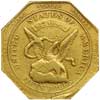 |
1851 U.S. Assay Office $50 "slug", 887 THOUS. Reeded edge. NGC graded EF-45. Lightly toned. Light to moderate marks on both sides, one of which causes weakness in the 87 in the fineness (.887 THOUS). The main devices are, however, strictly Extremely Fine quality, with good color around the devices. The U.S. Assay Office would produce what became the highest denomination U.S. gold coin to circulate up to that time -- octagonal-shaped $50 gold coin-ingots, often referred to as "slugs." On the $50 denomination the reverse design appears as a series of concentric circles in the center, surrounded by either overlapping lines or swirls that create a diamond effect (as on the lettered edge pieces), or a series of wavy, concentric circles (found on the reeded edge slugs). These concentric circular lines are known to mechanics as "engine turning,", the design is similar to the web-like engraving in the vignettes on paper money or on watchcases (PCGS # 10214) .
Estimated Value $18,000 - 22,000.
View details and enlarged photos
Check results on similar lots
| Unsold |
Lot 2782 |
 |
1852 U.S. Assay Office $50 "slug", 887 THOUS. Reeded edge. NGC graded AU-55. Lightly toned. Nice details. with some minor edge bruising and a small area of scuff lines through STATES to the top rim. Full clear date and other legends. The shield stripes show their lines and the eagle's only weakness is at the leg and claw holding the arrows.
During the heyday of the California Gold Rush, these $50 ingots or "slugs" or "Californians" as they were sometimes called, passed as money; for most of 1851-53 they were the principal accepted currency in California. Earlier dies gave the issuer's name as AUGUSTUS HUMBERT U.S. ASSAYER OF GOLD; later ones as UNITED STATES ASSAY OFFICE OF GOLD, but it was the same provisional branch mint, located at first on Montgomery St. between Commercial and Clay, later at 608-10 Commercial Street. Humbert arrived in San Francisco on Jan. 30, 1851, bringing master dies or hubs, and on Jan. 31 he struck his first octagonal ingots. Quantity issue began February 14. Anticipating Humbert's arrival, Collector of Customs T. Butler King was authorized by President Millard Fillmore, December 2, 1850, to receive any or all issues of the new Assay Office in payment of tariffs: a de facto recognition that they passed as federal money, effective from the first day of issue (PCGS # 10217) .
Estimated Value $30,000 - 34,000.
View details and enlarged photos
Check results on similar lots
| Realized
$43,700 |
Lot 2783 |
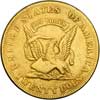 |
1852 Moffat & Co. (San Francisco) TWENTY DOLS. 2 over 1. Sharpness of VF-20. Cleaned and repaired with natural wear from circulation (these did hard duty in gold-rush California of the early 1850s). The Type with 884 Thous fineness is several times scarcer than the more often seen .900 Fine pieces. The earlier firm of Moffat & Company was dissolved in 1852 and a newly reorganized company known as the Unnited States Assay Office of Gold took over the government contract to strike gold. The principals of the Assay Office were Curtis, Perry, and Ward.
Estimated Value $3,000 - 3,500.
View details and enlarged photos
| Unsold |
Lot 2784 |
 |
1852 U.S. Assay Office $50 Gold, 887 THOUS. . NCS AU Details. Repaired, Improperly cleaned. Still a very nice coin with all the design details plainly evident. This includes the legends around the rim as well as the date. In small letters, the legend reads AUGUSTUS HUMBERT UNITED STATES ASSAYER OF GOLD SAN FRANCISCO 1852. A popular type, and one of the most romantic gold pieces to survive the era of the California Gold Rush. Vast numbers of these $50 ingots were struck, but thousands of them were subsequently melted (to be turned into $20 U.S. gold pieces) once the mint at San Francisco opened its doors in 1854. Today they are scarce. The era in which these circulated is but a blink of the eye, looking back over the span of 150+ years. Three or four short years, but in their heyday they were a necessary requirement for business and trade transactions to take place.
Estimated Value $6,000 - 7,000.
View details and enlarged photos
| Unsold |
Lot 2785 |
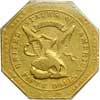 |
1852 U.S. Assay Office $50 Gold, 900 THOUS. PCGS graded EF-45. Mostly untoned. A popular large US gold coin. From January 1851 through much of 1852, the U.S. Assay Office struck the massive 2-1/2 ounce $50 gold ingots or "slugs." Smaller denominations would follow, but it is the $50s that are the most famous today. The U.S. Assay Office fifties early on were in several finenesses, with this specimen being coin-standard at .900 Fine. The alloy was mixed with silver and some copper. A smidgen of luster remains deep in the eagle's feathers of this attractive piece. It shows clear lettering around the margin (often worn on even high grade pieces) and a full date. Only a few light abrasions, none of which cause injury to the eight corners. Pop 12; 22 finer. (PCGS # 10019) .
Estimated Value $18,000 - 22,000.
View details and enlarged photos
Check results on similar lots
| Realized
$32,200 |
Lot 2786 |
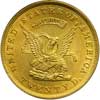 |
1853 U.S. Assay Office $20 Gold, 900 THOUS. PCGS graded MS-64 PQ. Lovely light yellow gold toning. Well struck and choice. Always frosty for the issue, as seen here, the bright yellowish gold surface is nearly Gem quality with fine granular frost typical of Assay Office gold piece when offered in Mint condition, and best of all, no distracting bagmarks. Judged from an aesthetic standpoint, the coin is also possessed of a much finer strike than is typically found for a $20 issue.
Following the first issues of $50 octagonal gold slugs, on Dec. 9, 1851, Treasury Secretary Corwin through the Congress authorized the Assay Office to issue $10s and $20s. Production began Feb. 12, 1852. The U.S. Assay Office $20 coins are found in the Territorial and private mint gold coinage sections of most U.S. coin guides, but in fact the U.S. Assay Office was the forerunner of what would become the San Francisco Mint (which began striking quarter eagles, half eagles, eagles, and double eagles in 1854). Pop 16; 5 in 65 (PCGS # 10013) .
Estimated Value $15,000 - 20,000.
View details and enlarged photos
Check results on similar lots
| Realized
$26,450 |
Lot 2787 |
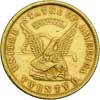 |
1853 U.S. Assay Office $20 Gold Eagle. Sharpness of AU-50. Light nicks and some scratches. Nice golden color. If one were to take a poll, we'd see that the strike is above standard for the Assay Office issue in being sharp with the excellent metal flows on both sides into the deepest die recesses. The shield stripes are nicely split, the eagle's neck, leg and wing feathers complete, and the scroll lettering also plain to read.
Estimated Value $3,000 - 3,400.
View details and enlarged photos
| Unsold |
Lot 2788 |
 |
1855 Wass, Molitor & Co. (San Francisco) $50 Gold. NGC graded AU-53. NGC holder 1921836-005. Normal small light marks in the fields. An historic and nicely preserved $50 gold piece whose rare beauty comes with fully defined design features plus a strict limitation on surface marks. What's more, the rims are choicer than average for this often bunged-about Type, wherein use in circulation tended to damage the soft rim areas. While the octagonal fifties from the Assay Office get much of the news coverage in the American numismatic press, that is only because they are seen ten times as often as a Wass $50 piece.
The firm of Wass, Molitor & Company was comprised of Samuel Wass and Agoston Molitor, who operated their well-respected private mint in the Bay area from 1852. Their first deliveries consisted of five- and ten-dollar gold pieces for local use. They ceased minting when the San Francisco Mint opened in 1854, but resumed with production of the famous $50 denomination round gold coins in 1855. This was at a time when the federal facility was obliged to close from time to time for lack of proper parting acids to refine gold dust with the requisite copper alloy. The fifty dollar Wass, Molitor pieces filled the void at this critical time. Reports are the Wass Molitor coinage had one of the highest intrinsic values of any of the private issues in California. Many were subsequently melted. Pop 3; 13 finer, 4 in 55, 2 in 58, 3 in 60, 1 in 61, 2 in 63, 1 in 64 (PCGS # 10363) .
According to Dr. Donald Kagin, "Wass, Molitor & Co. closed down their operation soon after the 1855 issues were distributed, for the 1856-1857 San Francisco Directory lists the assaying firm of Wass (Karoly) Usznay & Co. as operating during 1856 and 1857. Haraszthy replaced Molitor as partner in this firm, as the latter had left California for London in 1856." Dr. Kagin's book "Private Gold Coins and Patterns of the United States," gives an exciting account of the Territorial issues, including a full description of the Wass, Molitor company.
Estimated Value $70,000 - 80,000.
View details and enlarged photos
Check results on similar lots
| Unsold |
|
|